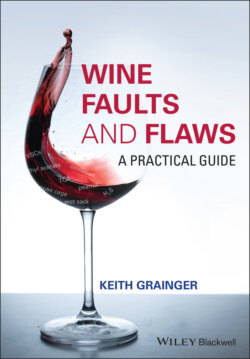Читать книгу Wine Faults and Flaws - Keith Grainger - Страница 76
2.7.3 Dryness/Sweetness
ОглавлениеBefore discussing perceptions of sweetness, it is pertinent to visit the topic of grape sugars briefly. Grapes contain glucose (grape sugar) and fructose (fruit sugar) which will be completely or partially converted by the action of yeasts to ethanol and carbon dioxide during the fermentation process. If there is insufficient natural sugar in grapes to produce a balanced wine with the required alcoholic degree, in some countries the winemaker may add sucrose to the must, a process generally known as must enrichment or chaptalisation. There can be no doubt that the process reduces a wine's concentration. In theory, any added sucrose should be fermented to dryness. The purpose of chaptalisation is not to produce wines with sweetness. However, in practice, most fermentations cease before total dryness, as discussed below. At the time of writing, chaptalisation remains permitted in the more northerly zones of the European Union (EU), and incredibly is sometimes undertaken even in ‘good’ years when grape ripeness should not be a problem. For example, 2016 is generally regarded as an excellent year in Bordeaux, but chaptalisation of vats of Cabernet Sauvignon, Cabernet Franc, and Petit Verdot was permitted, and undertaken, in many districts. An alternative to chaptalisation is the addition of concentrated grape must which is comprised largely of glucose and fructose.
Sweetness, if any, in a wine will be particularly detected on the tip of the tongue. It is important to remember than we cannot smell sweetness (sugar is not volatile), although the nose of some wines may lead us to expect that they will taste sweet. This may or may not be the case. For example, a wine made from one of the families of Muscat varieties may have a fragrant and aromatic nose reminiscent of sweet table grapes, but the wine may be bone dry when tasted. Other characteristics can also give an illusion of sweetness, in particular, high‐alcohol levels (although sometimes too much alcohol can lead to a bitter taste), and vanillin oak. Thus, a high‐alcohol wine that has undergone oak treatment can mislead the taster into perceiving that it is sweeter than the actual level of residual sugar. Pinching the nose whilst rolling the wine over the tip of the tongue can help the novice overcome any distortions that the nose may be giving. However, the acidity of the wine also impacts on the taster's perception of sweetness. The higher the acidity, the less sweet a wine containing residual sugar may appear to be.
Thresholds for detecting sweetness vary according to the individual. Nearly 50% of tasters can detect sugar at a concentration of 1 g/l or less, with just 5% unable to detect sugars at more than 4 g/l. Residual sugar in a wine is due to fructose remaining after the fermentation. The level of residual sugar in white wine can range from 0.3 to 300 g/l. Most high‐quality red wines are fermented to dryness or ‘off’‐dryness, i.e. between 0.2 and 3 g/l of residual sugar. However, because dry wines are very fashionable, some wines are labelled or described as ‘dry’ when they are not. It is common for many New World branded whites, particularly Chardonnays, to have between 5 and 10 g/l of sugar, and popular branded New World reds may contain up to 8 g/l. A small amount of residual sugar in white wine helps to soften any bitterness, and a little sweetness in red wine can serve to balance any phenolic astringency.
